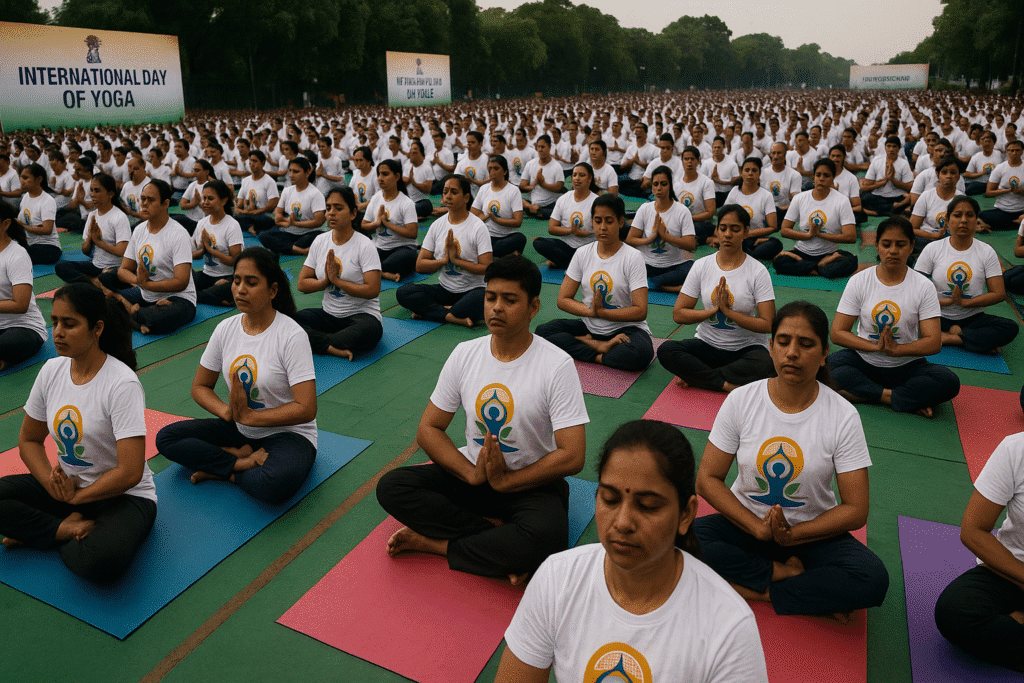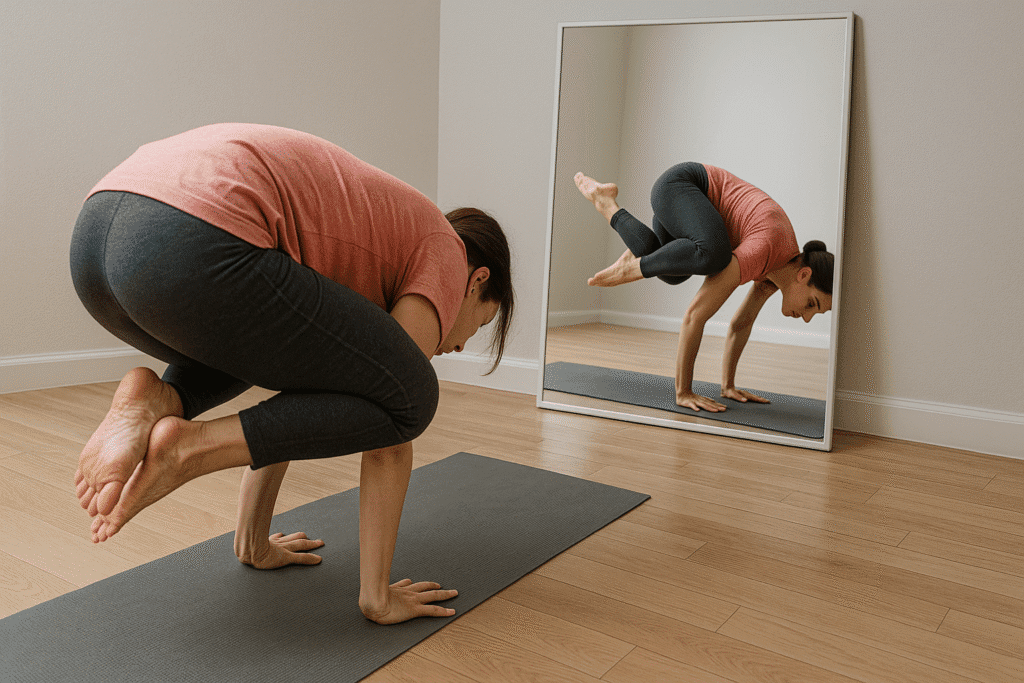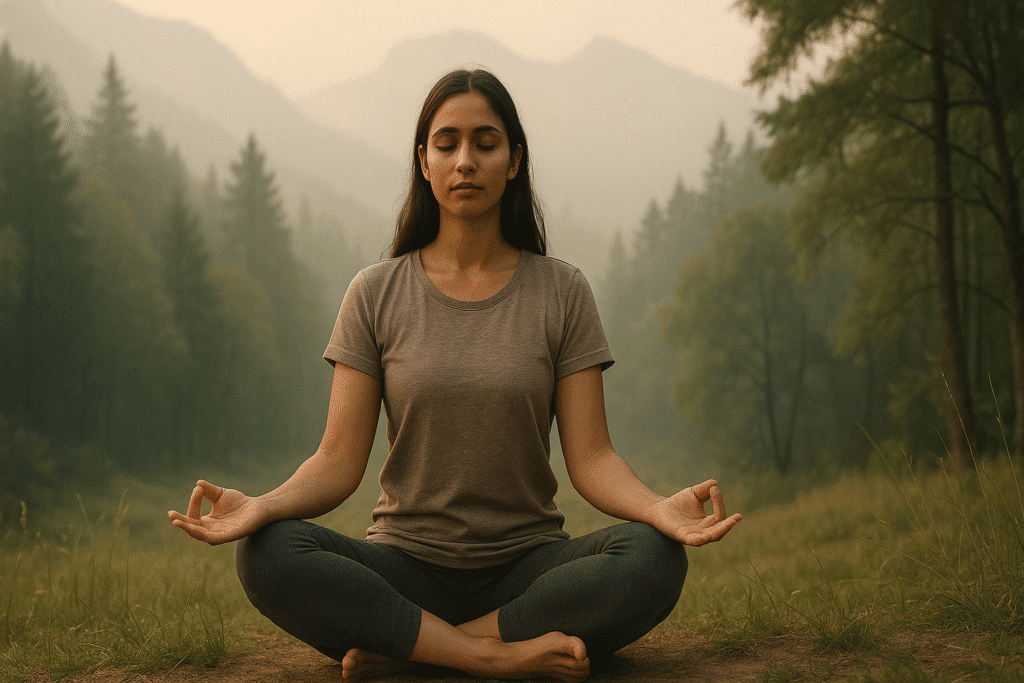Introduction

Everyone says yoga is the answer — to stress, pain, anxiety, and even spiritual awakening.
But here’s the uncomfortable question: Is yoga really all it’s cracked up to be?
We’ve been told that simply sitting, breathing, and stretching can transform our minds and bodies.
Yet depression rates are rising. Burnout is everywhere. And despite the explosion of yoga studios and influencers, many people still feel… lost.
So what’s going on?
Modern yoga looks nothing like the ancient practice found in scriptures.
It’s marketed more like a lifestyle brand than a spiritual path.
From glossy retreats to hashtag wellness, yoga’s turned into an $88 billion industry — and that raises questions.
Is yoga today a watered-down version of ancient wisdom?
Worse — has it become a government-endorsed distraction from deeper health issues?
This blog isn’t here to cancel yoga.
But we are here to pull back the curtain — to compare the truth vs the trend, the discipline vs the dopamine, and to ask:
Does yoga still serve its original purpose — or has it been hijacked by hype?
Let’s break it down.
The Yoga You Know vs. The Yoga That Was
🔹Yoga Was Never Meant to Burn Calories
Traditional yoga wasn’t about getting abs or “toning.”
In ancient India, yoga was a path to spiritual discipline — often practiced by renunciates, not fitness fans.
Movement was just a small part; the real work was done in the mind.
🔹From Sacred to Stylized
Today’s yoga classes often involve upbeat music, scented candles, and branded gear.
But if you go back to the Yoga Sutras of Patanjali, you’ll find silence, stillness, and surrender — not power poses and playlists.
Modern yoga = performance. Ancient yoga = presence.
🔹Yoga in the Vedas and Gita
The Bhagavad Gita mentions four types of yoga — none of which involve poses:
- Karma Yoga (action)
- Bhakti Yoga (devotion)
- Jnana Yoga (knowledge)
- Raja Yoga (meditation)
There was no “hot yoga,” no flow sequence.
It was about conscious living, not contorting the body.
🔹Colonial Disruption & Western Reinvention
Much of what we call yoga today was reshaped during British rule and later exported globally.
What survived was mostly asanas (postures) — the most visible and commodifiable part.
Spirituality got trimmed to fit the Western wellness narrative.
🧘💰The Rise of the Yoga Industry — And Who’s Cashing In

🔹From Philosophy to Profit
Yoga, once a path to liberation, is now a multi-billion dollar global business.
Studios, mats, retreats, activewear — it’s all monetized.
Wellness influencers sell the idea that you can “manifest your dream life” through handstands and hashtags.
But is that yoga — or just marketing?
🔹The $88 Billion Wellness Machine
The wellness industry is projected to hit $88 billion, and yoga plays a massive role.
From online classes to retreats in Bali, the focus is more on aspirational living than inner peace.
Let’s be honest — do most people leave a yoga class enlightened, or just sweaty?
🔹Yoga as a Political Tool
In some countries, especially India, yoga has been institutionalized by the government — positioned as cultural pride and soft power.
While it may promote health on paper, critics argue it also distracts from systemic health failures and rising mental health crises.
🔹Gatekeeping Spirituality
Modern yoga can feel exclusive.
Classes are often expensive. Spaces are curated.
Instead of a path toward universal awareness, it’s become elitist wellness dressed in Sanskrit terms.
🔹 What They Don’t Tell You About Yoga Day
You’ve probably seen it all over social media — people in parks, rows of mats, doing synchronized poses for International Yoga Day.
Sounds good, right? Promoting health, unity, mindfulness…
But here’s what most people don’t know:
Yoga Day was created by the Indian government — not ancient sages.
It was launched in 2015 as a global celebration, but behind the scenes, it’s more about politics than peace.
Let’s break it down:
- The yoga showcased on this day is mostly physical — no deep meditation, no real spiritual depth.
- It’s designed to highlight India’s cultural heritage — fair — but also used as soft political power on the world stage.
- At home, it’s been criticized for sidelining minority groups who don’t feel connected to this version of yoga. Some even see it as a subtle tool for pushing a cultural narrative under the label of wellness.
So while millions roll out their mats, thinking they’re part of something ancient and sacred, the reality is:
Yoga Day isn’t about spiritual awakening — it’s a stage.
Yoga and Mental Health — The Myth of Mind Over Matter

🔹Can Stretching Really Heal Trauma?
Modern yoga often claims to reduce anxiety, depression, and even trauma.
But here’s the reality: no posture can replace real therapy.
Mental health is deeply chemical, emotional, and situational — not just about breathing techniques and backbends.
Yoga may help you relax. But so does music, walking, or even a deep nap.
Let’s stop selling it as a cure.
🔹Spiritual Bypass in the Name of Zen
Ever heard someone say, “Just do more yoga” when you’re struggling?
That’s called spiritual bypass — using spiritual practices to avoid real emotional work.
People are taught to “breathe through the pain” — but some pain needs to be faced, not stretched away.
🔹Physical Stillness ≠ Mental Peace
Sitting cross-legged and closing your eyes doesn’t automatically lead to calm.
Many people actually feel more anxious or distracted during meditation or yoga.
That’s because real peace comes from inner work, not just posture.
Let’s not confuse discipline with healing.
🔹A Healthy Body Doesn’t Mean a Healthy Mind
Sure, yoga can improve flexibility and posture. But that doesn’t mean you’re mentally fit.
Mental wellness requires:
- Honest reflection
- Emotional literacy
- Support systems
- Sometimes, medical help
Yoga can be a tool — not the whole toolbox.
Yoga and the Productivity Trap — Is It Really About Self-Worth?

🔹Yoga as a “Life Hack”
The modern yoga scene is drenched in a “productivity culture.”
Yoga teachers and influencers are often selling more than just poses — they’re selling you the dream that with enough practice, you’ll unlock your most productive, most “successful” self.
The problem? Yoga is being marketed as a quick fix for life improvement, and it’s dangerous.
Not every challenge in life can be solved by a 30-minute morning routine.
🔹Are You Doing Yoga — or Chasing Perfection?
Social media is flooded with #yogagoals: perfect poses, serene faces, flawless Instagram feeds.
But is that the true goal of yoga?
Yoga was never about achieving perfection. It was about acceptance — of yourself, flaws and all.
When yoga becomes a measure of worth — and followers are the reward — it stops being a spiritual practice and becomes just another self-improvement hustle.
🔹Flexibility ≠ Balance
The current yoga industry makes you believe that physical flexibility leads to a balanced life.
In reality, life is more than just achieving the “perfect pose.”
True balance comes from emotional resilience, setting boundaries, and living authentically — not from stretching your body into a contorted shape.
The focus should be on building mental flexibility and emotional stability — things yoga, when done right, can support. But it’s not a magic pill for all your personal struggles.
🔹The Yoga Hustle: It’s a Business
Yoga’s global popularity isn’t just about wellness — it’s a multimillion-dollar industry.
Influencers, brands, and retreats are thriving by pushing the narrative that yoga is a way to get your life together — fast.
The catch? It’s built on personal insecurity, not personal growth. The more you feel you “need” yoga to fit in, the more you’re being sold a lifestyle.
Conclusion: The True Meaning of Yoga — Is It What We’re Really Practicing?

Yoga started as a spiritual practice aimed at personal growth and enlightenment. Over time, it’s been turned into a global fitness trend, commodified and packaged to fit neatly into a lifestyle of self-improvement and success. But the real essence of yoga — a pathway to inner peace, self-awareness, and mental clarity — often gets lost in the noise of modern-day marketing.
While yoga can be an excellent tool for physical health and can offer moments of mindfulness, we must ask ourselves:
Are we practicing yoga for its true purpose? Or are we simply caught up in the cycle of performance, perfection, and external validation?
The deeper question is whether we’re willing to look beyond the asanas and rediscover yoga in its original form — a practice that connects the mind, body, and spirit, and helps us find peace not through a perfect Instagram pose, but through personal growth and reflection.
So, before you sign up for another trendy yoga class or buy that branded yoga mat, think about this:
Are you practicing yoga for real transformation, or just the next shiny trend?
📚 Final Thought
Yoga’s roots are deeply tied to mindfulness and spiritual awakening. If we can remember that, we might just reclaim the true power of this ancient practice, rather than continue to let it be diluted by modern consumerism.
The real change begins when we bring more awareness into every aspect of our life — and that’s a lesson yoga can still teach, if we’re willing to listen.
❓ Frequently Asked Questions
Is yoga really a scam?
No, yoga itself isn’t a scam. The scam lies in how modern yoga has been commercialized and turned into a marketable product. Yoga, in its essence, is about self-awareness, inner peace, and physical health. The problem arises when it’s used as a tool for marketing personal brands, or as a shortcut to “success” without addressing the deeper mental and spiritual aspects.
Can yoga help with mental health?
Yoga can absolutely be a tool for mental well-being, offering relaxation and stress relief. However, it’s important to recognize that it’s not a cure-all for serious mental health issues. Mental health requires a combination of therapies, support systems, and sometimes professional help. Yoga should be seen as complementary, not a sole solution.
Why is International Yoga Day controversial?
International Yoga Day, celebrated on June 21st, was initiated by the Indian government in 2015 to promote yoga globally. While it has noble intentions, it’s criticized for oversimplifying yoga as just physical postures, leaving out the philosophical and spiritual depth that yoga is rooted in. Additionally, it’s used as a political tool to push a national agenda, which can alienate those who practice yoga for personal or spiritual reasons. A true peace seeker may celebrate yoga 365 days not just on 21st June clicking pics on a mat doing Yoga pose.
Does yoga really lead to success and happiness?
While yoga can improve physical health and bring moments of mindfulness, it doesn’t automatically lead to success or happiness. True success and lasting happiness come from addressing your mental health, relationships, and life goals. Yoga can help improve focus and reduce stress, but it’s not a shortcut to a perfect life.
What’s the difference between traditional yoga and modern yoga?
Traditional yoga, as described in ancient texts like the Yoga Sutras, was a holistic practice focusing on mind, body, and spirit — with an emphasis on meditation and self-awareness. Modern yoga has often been stripped down to physical postures and fitness, leaving out the deeper spiritual aspects that made it a complete practice for inner transformation.
